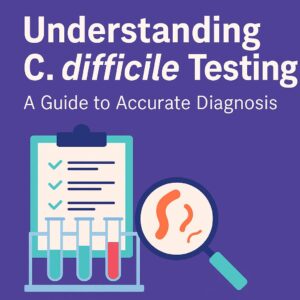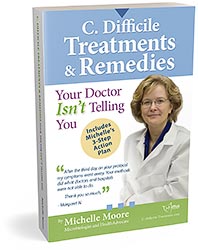 If you or someone you love is dealing with persistent diarrhea, one possible cause that often gets overlooked or misunderstood is C. difficile (Clostridioides difficile). Getting the right test is a big deal and it can mean the difference between proper treatment and ongoing symptoms that don’t go away.
If you or someone you love is dealing with persistent diarrhea, one possible cause that often gets overlooked or misunderstood is C. difficile (Clostridioides difficile). Getting the right test is a big deal and it can mean the difference between proper treatment and ongoing symptoms that don’t go away.
In this post, I’ll break down how C. diff testing works, why it can be confusing, and where you can go for a more in-depth explanation.
Why Accurate C. diff Testing Matters
Not all C. diff tests are created equal. Some tests look for the bacteria, others look for the toxin, and a few look for the DNA of the toxin-producing genes. It’s no wonder people and doctors alike can get conflicting or confusing results.
Misdiagnosis can lead to:
- Unnecessary antibiotics if you’re only colonized
- Missed infections if the test isn’t sensitive enough
- Delayed healing because you’re not treating the actual cause
That’s why most labs today use a multi-step testing algorithm to improve accuracy.
The 3 Main C. diff Tests Explained
1. GDH Test (Glutamate Dehydrogenase)
Looks for a protein made by all C. diff bacteria — both toxic and harmless.
✔️ Sensitive
❌ Not specific for active infection
2. Toxin Test (EIA for Toxin A and/or B) – The Gold Standard Test!
Detects the actual toxin that causes C diff. symptoms.
✔️ Positive = strong evidence of active infection
❌ Can miss infections if toxin levels are low or the sample isn’t fresh
3. NAAT (a PCR Test)
Looks for the gene that makes the toxin — but not actual toxins itself.
✔️ Very sensitive
❌ Can pick up colonization (people who have the bacteria but no symptoms)
How the Multi-Step Testing Algorithm Works
Most hospitals and labs now use this step-by-step approach starting with a GDH test, adding on an EIA toxin and possibly an NAAT test to confirm.
1. GDH = Positive >> C. diff bacteria is present
2. EIA Toxin = Positive >> Infection confirmed and you’re making C. diff toxins
2. EIA Toxin = Negative >> Add NAAT test to check if the strain is toxigenic
3. NAAT = Positive >> May have infection. Use clinical judgment based on symptoms and risk factors
3. NAAT = Negative >> Probably colonized, not infected
Learn More: In-Depth Guide to C. diff Testing
This article is based on our in-depth, easy-to-understand guide on C. diff testing, available on this website. To learn more, you can watch my video about C. difficile testing:
You can also click here to read the full guide on C. diff testing.
It explains each test in plain English, shows how to interpret different result combos, and helps you make sense of your own test report.

About the Author – Michelle Moore, BSc
Michelle Moore is a microbiologist, holistic health educator, and author of C. difficile Treatments & Remedies. With over 10 years of experience in pharmaceutical research and over 20 years in natural medicine, she helps people overcome C. difficile and other chronic infections naturally.
References
- Centers for Disease Control and Prevention (CDC). “Clinical Testing and Diagnosis for CDI.” March 6, 2024. https://www.cdc.gov/c-diff/hcp/diagnosis-testing/index.html
- Mayo Clinic. “C. difficile infection – Diagnosis and treatment.” September 1, 2023. https://www.mayoclinic.org/diseases-conditions/c-difficile/diagnosis-treatment/drc-20351697
- Centers for Disease Control and Prevention (CDC). “C. diff: Facts for Clinicians.” January 17, 2024. https://www.cdc.gov/c-diff/hcp/clinical-overview/index.html
- Mayo Clinic. “Pseudomembranous colitis – Diagnosis & treatment.” September 1, 2023. https://www.mayoclinic.org/diseases-conditions/pseudomembranous-colitis/diagnosis-treatment/drc-20351439
- Centers for Disease Control and Prevention (CDC). “Clinical Guidance for C. diff Prevention in Acute Care Facilities.” March 8, 2024. https://www.cdc.gov/c-diff/hcp/clinical-guidance/index.html
- Mayo Clinic. “Antibiotic-associated diarrhea – Diagnosis & treatment.” https://www.mayoclinic.org/diseases-conditions/antibiotic-associated-diarrhea/diagnosis-treatment/drc-20352237
- Centers for Disease Control and Prevention (CDC). “About C. diff.” December 18, 2024. https://www.cdc.gov/c-diff/about/index.html


 Fill in the form below to get our C. diff. tips newsletter and your free report “10 Things You Need to Know to Overcome C. difficile”.
We value your Privacy. Your email will be kept strictly confidential & secured. See our
Fill in the form below to get our C. diff. tips newsletter and your free report “10 Things You Need to Know to Overcome C. difficile”.
We value your Privacy. Your email will be kept strictly confidential & secured. See our 
